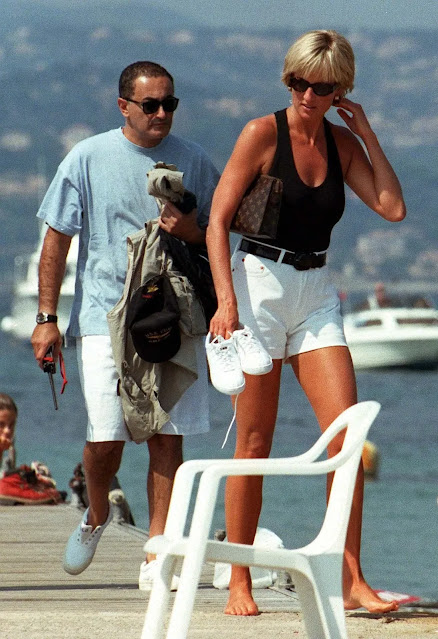 |
| Diana and Dodi |
Princess
Diana, whose full name was Diana Frances Spencer, led a captivating and often
tumultuous life before her tragic death. Here is an overview of her life, her
impact on the world, and the circumstances surrounding her untimely demise:
Early
Life:
Birth
and Family: Diana was born on July 1, 1961, in Park House, Sandringham,
Norfolk, England. She was the fourth of five children born to John Spencer, the
8th Earl Spencer, and Frances Shand Kydd.
Education:
Diana attended several schools in England and Switzerland, eventually working
as a nursery assistant and a part-time cleaner.
Marriage
to Prince Charles: On July 29, 1981, Diana married Prince Charles, the heir to
the British throne, in a lavish ceremony at St. Paul's Cathedral in London. The
wedding was watched by millions around the world.
Life as
Princess of Wales:
Public
Role: Diana became the Princess of Wales and quickly captured the hearts of the
British public and people worldwide with her charisma, beauty, and charity
work.
Charitable
Work: Diana was known for her humanitarian efforts, particularly in raising
awareness about issues like HIV/AIDS, landmines, and mental health. She was
involved with numerous charitable organizations.
Marital
Struggles: Diana's marriage to Prince Charles faced numerous challenges,
including their age gap and incompatible personalities. Their relationship
became strained, leading to their separation in 1992 and eventual divorce in
1996.
Tragic
Death:
Car
Crash in Paris: On August 31, 1997, Diana, along with her companion Dodi Fayed,
died in a car crash in the Pont de l'Alma tunnel in Paris. Their chauffeur,
Henri Paul, was also killed in the accident.
Conspiracy
Theories: Diana's death resulted in numerous conspiracy theories, with some
speculating that she was murdered. However, multiple investigations and
inquests have concluded that the crash was a result of excessive speed and the
chauffeur's intoxication.
Legacy:
Humanitarian
Impact: Diana's legacy lives on through her charity work. Her advocacy for
causes like landmine removal and AIDS awareness helped destigmatize these
issues and raised significant funds for related charities.
Cultural
Influence: Diana's style and fashion choices had a lasting impact on the
fashion industry. Her iconic looks continue to inspire designers and fashion
enthusiasts.
Royal
Family Dynamics: Diana's life and death had a profound effect on the British
monarchy. Her story has prompted discussions about the role and expectations of
the royal family, particularly regarding the treatment of its members by the
media.
Princess
Diana's life was indeed enigmatic, marked by her incredible charity work,
personal struggles, and a tragic end that continues to captivate the public's
imagination. Her memory lives on through her enduring impact on charitable
causes and her lasting influence on popular culture.
The
secrets of her death
Princess Diana's death in a car crash in Paris
in 1997 was a tragic event that led to numerous conspiracy theories and
speculations. However, official investigations, including a lengthy inquest in
the United Kingdom, concluded that her death was the result of a tragic
accident and not the product of a conspiracy or foul play. Here are the key
facts surrounding her death:
Car
Accident: Princess Diana died in a car crash in the Pont de l'Alma tunnel in
Paris on August 31, 1997. Her companion, Dodi Fayed, and the chauffeur, Henri
Paul, were also killed in the accident. Another passenger, Diana's bodyguard
Trevor Rees-Jones, survived but was seriously injured.
Speed
and Intoxication: The investigation into the crash determined that excessive
speed was a major factor. Henri Paul, who was driving the car, was found to
have a high level of alcohol in his blood, and he was also taking prescription
drugs. These factors impaired his ability to drive safely.
Paparazzi
Pursuit: It was widely reported that paparazzi photographers were chasing the
car at high speed, trying to capture images of Diana and Dodi. While the
paparazzi's behavior was criticized and considered intrusive, it was not found
to be a direct cause of the crash.
Conspiracy
Theories: Despite the official investigations' conclusions, conspiracy theories
about Princess Diana's death have persisted. Some of these theories suggest
that she was intentionally killed to prevent her from marrying Dodi Fayed or
that the British royal family was involved. These claims have been widely
discredited and debunked.
Inquests:
There were several inquests and investigations into Diana's death, including a
French inquiry and an official inquest in the United Kingdom. The UK inquest, which
took place from 2007 to 2008, concluded that Diana and Dodi Fayed were
unlawfully killed due to the grossly negligent driving of Henri Paul and the
pursuing paparazzi.
In
summary, the official investigations into Princess Diana's death determined that
it was a tragic accident resulting from excessive speed, Henri Paul's
intoxication, and the paparazzi's presence. While conspiracy theories have
persisted over the years, there is no credible evidence to support the idea
that her death was the result of foul play or a conspiracy.
Her
relationship with Dodi
Princess
Diana's relationship with Dodi Fayed was a relatively short-lived but highly
publicized romance that drew significant attention from the media and the
public. Here's an overview of their relationship:
Meeting
and Romance: Princess Diana and Dodi Fayed first met in the summer of 1997
while vacationing in the Mediterranean. Dodi was the son of Mohamed Al-Fayed, a
wealthy Egyptian businessman. Their relationship quickly became romantic, and
they were often photographed together during their holiday on the French
Riviera.
Media
Attention: The relationship between Princess Diana and Dodi Fayed garnered
intense media scrutiny, as Diana had recently divorced Prince Charles, and her
every move was closely watched by the paparazzi. The paparazzi followed the
couple relentlessly during their time together.
Romantic
Getaways: Diana and Dodi spent time together on Dodi's family yacht and at the
Fayed family's residence in Saint-Tropez, France. They were seen enjoying each
other's company and engaging in activities such as jet-skiing and dining at
exclusive restaurants.
Public
Interest and Speculation: The public's fascination with Diana's love life,
combined with her relationship with Dodi, fueled speculation about the nature
and future of their romance. There were rumors of an impending engagement,
although no official confirmation was made.
Tragic
End: Sadly, their relationship was cut short by the tragic car accident in the
Pont de l'Alma tunnel in Paris on August 31, 1997. Both Diana and Dodi Fayed
were killed in the crash, along with their chauffeur, Henri Paul. Diana's
bodyguard, Trevor Rees-Jones, survived the accident but was seriously injured.
Controversy
and Conspiracy Theories: Following their deaths, there were conspiracy theories
suggesting that their relationship and the circumstances of their death were
part of a larger conspiracy. These theories have been widely discredited, and
official investigations concluded that the crash was a tragic accident.
In
summary, Princess Diana's relationship with Dodi Fayed was a brief but
high-profile romance that captured the attention of the world. Their time
together was marked by intense media scrutiny, and their tragic deaths in the
car crash in Paris brought their relationship to a heartbreaking end.
What
about the secret services?
There
is no credible evidence to support the notion that any secret service or
intelligence agency played a role in the tragic death of Princess Diana.
Official investigations into the circumstances of her death, including
inquiries conducted by both French and British authorities, as well as an
extensive inquest, concluded that her death was the result of a tragic
accident, primarily caused by excessive speed, the intoxication of the
chauffeur Henri Paul, and the presence of pursuing paparazzi. Here are some key
points regarding the role of secret services in her death:
French
Investigation: The French authorities conducted a thorough investigation into
the car crash that claimed the lives of Princess Diana, Dodi Fayed, and Henri
Paul. This investigation did not uncover any evidence of foul play or
involvement by secret services.
British
Inquest: The United Kingdom conducted an inquest into the deaths of Diana and
Dodi, which concluded in 2008. The inquest, led by Lord Justice Scott Baker,
also found no evidence to support claims of secret service involvement or a
conspiracy.
Paparazzi
and Speed: The primary contributing factors to the crash were identified as
excessive speed and the impaired condition of the driver, Henri Paul, who was
found to be over the legal alcohol limit. The presence of pursuing paparazzi
was seen as a secondary factor but not a direct cause of the crash.
Conspiracy
Theories: Despite the official findings, conspiracy theories have persisted
over the years, suggesting that Diana's death was an orchestrated plot
involving various intelligence agencies. These theories lack credible evidence
and have been widely debunked.
It is
essential to rely on the conclusions of the official investigations and
inquests, which were conducted with the aim of uncovering the truth surrounding
Princess Diana's tragic death. These investigations did not find any credible
evidence to support claims of secret service involvement, and the prevailing
consensus remains that the accident was a result of a combination of factors
unrelated to foul play or a conspiracy.
who benefited
from Diana s death?
The
death of Princess Diana was a tragic event that did not result in any clear or
direct benefits for any specific individuals or groups. Instead, her untimely
passing was met with shock, grief, and a sense of loss by people around the
world. It had a profound impact on both the British royal family and the
public. Here are some perspectives on how different groups and individuals were
affected by Diana's death:
The
British Royal Family: Diana's death brought considerable scrutiny and criticism
to the royal family. At the time of her death, she was a prominent and beloved
figure, and her passing led to questions about the monarchy's ability to adapt
to changing times and public sentiment. The royal family faced criticism for
their response to her death and the perception of being distant from the
public's grief.
The
Public and Her Supporters: Princess Diana was widely admired for her
humanitarian work and her ability to connect with people from all walks of
life. Her death had a profound impact on her supporters, who mourned her loss
deeply. Many continue to honor her memory through charitable work and advocacy
for the causes she championed.
Media
and Paparazzi: Diana's relationship with the media was complex. Her death
prompted discussions about media intrusion into the private lives of public
figures and the role of paparazzi in pursuing celebrities aggressively. It led
to calls for greater privacy protections for public figures and their families.
Charitable
Causes: Diana's death led to increased attention and support for the charitable
causes she had championed during her lifetime. Organizations related to issues
such as landmine removal and HIV/AIDS saw an uptick in donations and awareness.
Conspiracy
Theorists: Some conspiracy theorists have attempted to suggest that various
individuals or organizations benefited from Diana's death, often advancing
unfounded claims. These conspiracy theories, however, lack credible evidence
and have been widely debunked.
It's
important to note that Princess Diana's death was ultimately a tragic event
that left a lasting impact on her family, friends, and the world. While it
prompted discussions and changes in various aspects of society, it is not
accurate to attribute clear benefits to specific individuals or groups as a
result of her passing.
